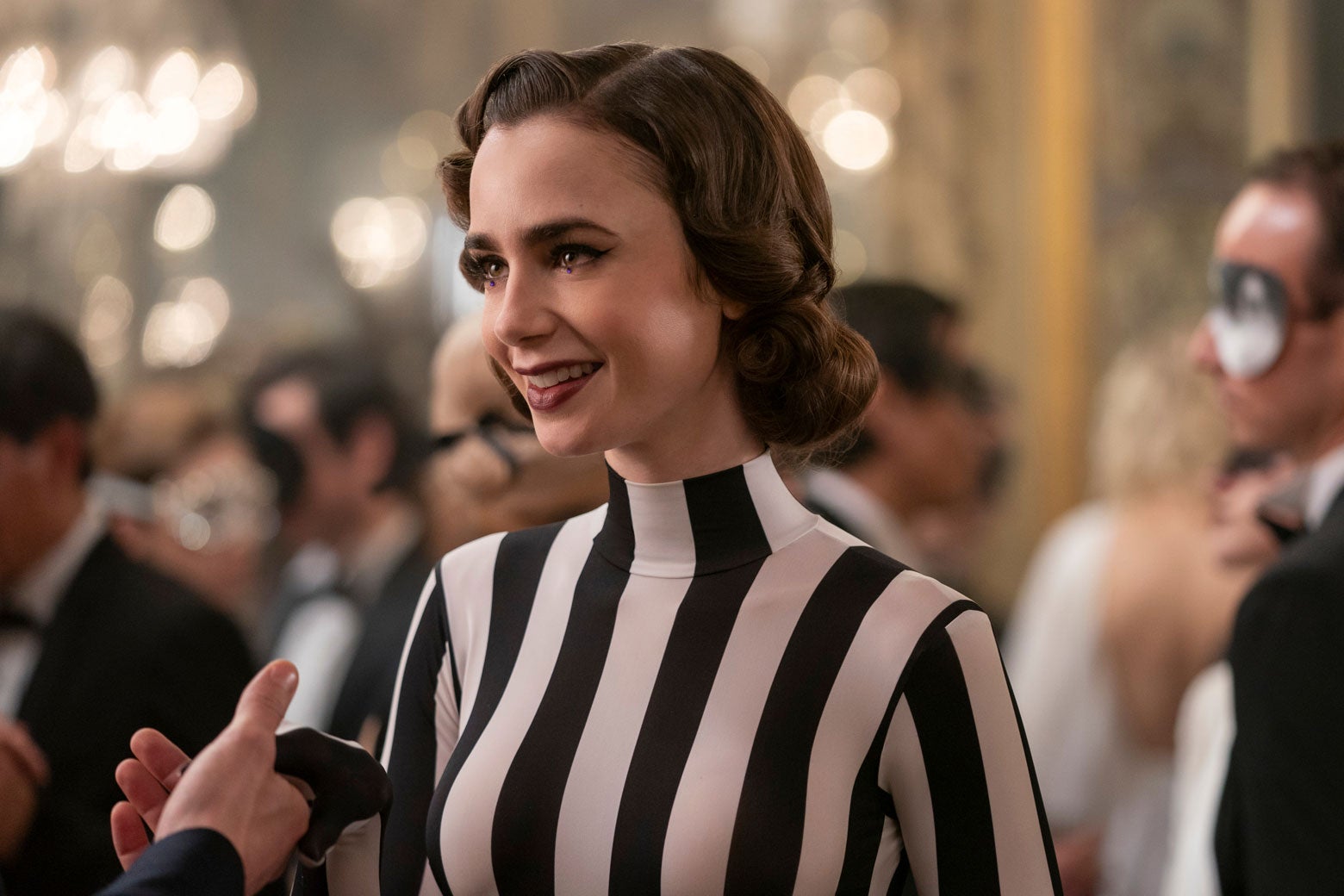Netflix’s most embarrassing series is back for its fourth season. I’m absolutely thrilled.

There’s a moment in the newest season of Emily in Paris that perfectly captures my feelings about this insipid yet strangely alluring Netflix show. The titular Emily (Lily Collins) and her friend/love rival Camille (Camille Razat) find themselves feuding in Claude Monet’s garden in Giverny, outside Paris. There, in the water lily pond that inspired some of the most astonishing and beautiful art in human history, the two women bicker until they fall out of their respective rowboats and splash into the water. As I watched the pair swim for the shoreline, I wondered to myself exactly how much money Netflix must have forked over for the privilege of defiling such a sacred space. As the women dry off, Camille tries to explain to Emily, who appears to have the education of a golden retriever, why Monet’s attempts at capturing nature through Impressionism were so inspiring. “None of it is perfect,” she says, “but all of it is beautiful.”
Oui, oui, bébé.
Now in its fourth season—the first five episodes of which went live on Thursday, with the next five coming Sept. 12—Emily in Paris is, as the complex title hints at, a show about Emily in Paris. Played by Collins as an eternally upbeat ingenue, Emily is an American marketing maven working for a French firm led by Sylvie (Philippine Leroy-Beaulieu), a Miranda Priestly–style siren who looks endlessly chic even as she delivers lines like “Your influencers are getting impatient, Emily!” The firm’s “work,” such as it is, consists mainly of going to lunches and attending galas.
Emily in Paris is not a good show. It has never been a good show. Its stars know that it’s not a good show—none more so than its French stars, who at first seemed somewhat embarrassed about participating in something so laden with cheap stereotypes, but who now seem to have turned off the parts of their brains that feel shame. But unlike much of the slop Netflix regularly churns out to fill the content void, Emily in Paris seems possessed of the self-awareness that it’s not a good show. Its creators appear stubbornly determined to keep things as pretty, lighthearted, and smooth-brained as Emily herself: This is television that wants you to have fun. Its cast is made up of cartoonishly gorgeous people who frequently kiss one another. Its characters never repeat an outfit or make a logical decision. It is stacked with more stunning aerial shots of Paris than the 2024 Olympics opening ceremony. None of it is perfect, but my God is it pretty.
Our heroine, Emily, is not a complicated person. She’s interested in men—well, just two specifically: the hunky English banker Alfie (a buff and thankfully frequently shirtless Lucien Laviscount) and the dreamy French chef Gabriel (Lucas Bravo, who appears to have been designed in a laboratory dedicated to Gallic good looks)—and she’s interested in her seemingly never-ending collection of couture that she somehow stores in the tiny apartment she shares with her friend Mindy (Ashley Park). Despite living in Paris for some time now, she has picked up barely any of the language, which doesn’t matter because everyone speaks English to her anyway, correctly assuming she’s an idiot. (To quote Home Alone, she is among what the French call “les incompétents.”)
And yet the show presents Emily as some sort of social media savant, a Don Draper for the digital age capable of devising incredible brand campaigns that leave all her colleagues and clients floored by her genius. More often than not, these ideas simply involve a hashtag and throwing a lavish party. “How is this a brand extension for the fragrance?” one character asks this season about a planned masquerade ball, in a moment of clarity that feels as if he is seeing color for the first time. (The skepticism is quickly quashed, and the ball appears to crush the agency’s KPIs of, I don’t know, number of influencer photos taken with a perfume bottle?)
The show borrows heavily from creator Darren Star’s previous series, including Sex and the City, but it’s Star’s Younger with which it shares the most DNA. Like Younger, Emily in Paris started with a singular conceit about a woman’s professional life (Sutton Foster’s Liza is pretending to be young! Emily is, er, in Paris!) that becomes less central to the series over time. Indeed, although the first season of Emily in Paris was so full of clichés about the French that it could have sparked a diplomatic incident, the show has—mercifully—largely moved on by now. If anything, most of the cultural observations this season are about the U.S.: One character smugly brags to Emily that abortion is still legal in France, while another bemoans that they won’t be receiving any public funding for their band: “No help from the government? What is this? America?!”
This season, the show’s focus has shifted firmly from French culture to its characters, who have been left rattled by the pregnant Camille’s decision to leave Gabriel at the altar because of his long-simmering feelings for Emily. It even tries its hand at some serious social commentary, with a #MeToo plotline in which Sylvie must decide whether to speak out against a lecherous fashion industry executive.
Season 4 covers new ground with Emily’s sex life too, although I still find it strange that a series positioned as a spiritual heir to Sex and the City (that show’s costume designer, Patricia Field, famously opted to work on Emily in Paris rather than the reboot And Just Like That …) and set in France, of all places, could be so coy about showing any actual sex. In one scene, Emily and a lover purportedly do the deed on her roof, but the camera quickly transitions away, and she later confesses that even that completely unseen moment was too spicy for her. Bridgerton gets away with much more.
But despite its quirks, Emily in Paris ultimately succeeds because, like Emily herself, it is oddly likable, despite all our better judgment. It’s breezy, stylish, and stupid—and proud of it, which is somehow rather charming.
In his newsletter Garbage Day, the internet culture writer Ryan Broderick recently tried to define what he termed “content slop,” referring to our society’s endless stream of low-culture garbage, whether it be nonsensical A.I. art on Facebook, endless Taylor Swift versions of her own songs, or Netflix shows. Labeling it the defining genre of the 2020s, Broderick writes that slop always feels forced upon viewers, who recognize that it is of little value. More than that, Broderick writes, “it not only feels worthless and ubiquitous, it also feels optimized to be so.”
I have no doubt that Netflix execs and the algorithm that they worship as a god have correctly determined that pretty clothes, hot men, and stock footage of Paris will get a bunch of girls and gays watching this show, which admittedly will never win awards or feature any real acting to speak of. That said, if Emily in Paris is slop (it is), then it’s junk that at least feels decadent and glamorous, like some rich and colorful patisserie creation that you know is bad for you unless consumed in small portions—as is the French style, after all.
As Gabriel tells Emily in one episode, after leaving the masquerade ball, “Why don’t we just forget about reality for one night and just stay in the fantasy?” In the famous, totally real words of Marie Antoinette: “Let them eat … slop.”



